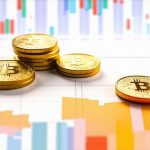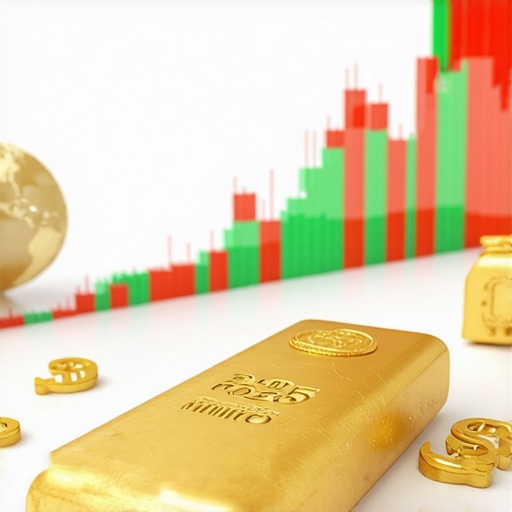Unveiling the Complex Dynamics of Gold Demand in 2025: A Strategic Perspective
As we navigate the intricate landscape of 2025, understanding the evolving patterns of gold demand across industry and consumer markets is paramount for investors, policymakers, and industry stakeholders alike. Gold, long regarded as a barometer of economic stability and a resilient asset class, is influenced by a confluence of factors ranging from geopolitical shifts to technological innovations. This article delves into the nuanced demand trends shaping the gold market in 2025, offering insights grounded in expert analysis and empirical data.
Supply Chain Disruptions and Their Impact on Gold Market Equilibrium
One of the pivotal challenges confronting the gold industry this year is the ongoing supply chain disruptions, which have been exacerbated by geopolitical tensions and pandemic-related constraints. These disruptions have not only affected gold mining output but also altered the dynamics of gold availability for industrial and consumer use. According to recent reports from the Gold Demand Trends in 2025, supply-side constraints are intensifying, prompting investors to reassess their portfolio allocations and fueling a strategic shift towards physical gold holdings.
Technological Innovations Driving Industrial Gold Applications
The integration of advanced technologies such as electronics, medical devices, and renewable energy systems is significantly influencing industrial gold demand. As the industry pivots towards more sophisticated applications, the demand for high-purity gold in manufacturing processes is expected to surge. This trend underscores the importance of understanding supply-demand dynamics, particularly in relation to how technological evolution can skew traditional market equilibria.
Consumer Market Trends and Cultural Shifts in Gold Consumption
In the consumer sector, gold continues to symbolize wealth preservation and cultural significance, especially in emerging markets. Notably, the jewelry industry remains a dominant driver of demand, with regional variations reflecting economic growth trajectories and cultural preferences. Moreover, the proliferation of gold-backed financial products, such as ETFs and digital assets, is expanding accessibility and influencing demand patterns. For a comprehensive overview, see our Guide to Gold Coins and Bullion.
How Will Geopolitical and Economic Factors Shape 2025 Gold Demand?
Geopolitical tensions, inflationary pressures, and central bank policies are key drivers impacting gold demand. As nations grapple with economic uncertainties, gold is increasingly perceived as a safe haven asset. Recent analyses suggest that central banks’ gold purchasing strategies are markedly influencing market prices, reinforcing gold’s role as a strategic reserve. For in-depth insights, refer to Central Bank Gold Purchase Trends.
What are the emerging debates among experts regarding the sustainability of gold demand in 2025?
Expert discussions revolve around the sustainability of rising industrial demand versus the potential for a market correction driven by geopolitical shifts or technological disruptions. The debate underscores the importance of dynamic risk assessment and diversification strategies in gold investment portfolios.
Investors aiming to capitalize on these trends should explore tailored strategies that leverage market analysis, such as the techniques outlined in our Proven Gold Trading Techniques. Staying informed about global demand shifts and supply constraints is crucial for making informed decisions in this volatile landscape.
For those interested in refining their portfolio, exploring supply-demand fundamentals and diversification through gold assets remains a cornerstone of resilient wealth-building in 2025. As the market continues to evolve, contributions from industry experts and ongoing research will be invaluable for navigating this complex terrain.
Deciphering the Nuances of Gold Consumption in 2025: An Investor’s Guide
Understanding the intricate demand patterns for gold in 2025 requires a nuanced approach that considers technological, geopolitical, and cultural factors. As industry insiders and seasoned investors know, gold’s role extends beyond mere aesthetics or wealth preservation; it is a dynamic asset responding to multifaceted influences. Recent data from Understanding Gold Supply and Demand Dynamics in 2025 highlights how shifts in industrial applications and consumer preferences are reshaping global demand.
How Will Technological Evolution Continue to Drive Gold’s Industrial Demand?
The ongoing integration of advanced technologies, including quantum computing, renewable energy solutions, and electronic devices, is set to elevate industrial demand for high-purity gold. This surge underscores the importance of understanding supply chain resilience and the potential bottlenecks that could impact availability. Experts suggest that staying ahead of technological trends requires a strategic focus on supply-side innovations and geopolitical stability, which influence the flow of gold into high-tech sectors. For a comprehensive analysis, explore our Global Supply-Demand Outlook.
What Cultural and Economic Shifts Are Shaping Consumer Gold Consumption?
As emerging markets continue their rapid economic growth, gold remains a potent symbol of wealth, cultural identity, and financial security. The jewelry sector, particularly in Asia and the Middle East, drives much of this demand, but recent trends also reveal a growing appetite for gold-backed digital assets and ETFs. These financial innovations are democratizing access and diversifying demand sources. For a detailed look at these patterns, see our Guide to Gold Coins and Bullion.
How Do Geopolitical and Economic Factors Intersect to Influence Gold Prices?
Geopolitical tensions, inflationary pressures, and central bank policies are converging to reinforce gold’s status as a safe haven. Notably, recent reports from the Central Bank Gold Purchase Trends indicate increased gold acquisitions by major economies, signaling strategic reserves reinforcement. This pattern suggests that geopolitical stability and monetary policy will continue to be pivotal in shaping market trajectories.
Can Gold Demand Sustain Its Growth Amidst Potential Market Corrections?
This question is at the heart of expert debates. While rising industrial and consumer demand fuels optimism, concerns about technological disruptions or geopolitical shifts could trigger corrections. The key lies in dynamic risk management and portfolio diversification strategies. For advanced insights, consult our Proven Gold Trading Techniques.
Investors seeking to navigate these complexities should also consider the importance of understanding supply-demand fundamentals, which are crucial for making informed decisions. Our detailed guides on gold market fundamentals offer valuable insights for building resilient portfolios in 2025. Staying informed about global demand fluctuations and supply constraints will be vital to capitalize on emerging opportunities and mitigate risks in this dynamic market environment.
Innovative Supply Chain Strategies to Bolster Gold Market Resilience in 2025
As the gold industry grapples with persistent supply chain challenges, forward-looking solutions are emerging that leverage blockchain technology for transparency and traceability. Integrating blockchain can significantly mitigate risks associated with illegal mining, forgery, and logistical inefficiencies. According to a recent study by the IMF, blockchain-enabled supply chains could reduce transaction costs by up to 30% and enhance trust among stakeholders, thereby stabilizing market supply and demand dynamics.
What role does geopolitical stability play in optimizing gold supply networks?
Geopolitical stability is crucial for maintaining uninterrupted gold flow, especially in regions rich in mineral resources. Strategic alliances, regional cooperation, and diplomatic engagement are vital to safeguard supply routes and mining operations. Research by the World Bank emphasizes that countries investing in political stability and infrastructure development tend to have more resilient mining sectors, directly influencing global gold availability and pricing.
The Future of Industrial Gold Usage: Innovations and Challenges
Emerging technologies such as quantum computing and nanotechnology are poised to revolutionize industrial applications of gold. For instance, quantum sensors utilizing gold nanoparticles could enhance precision in medical diagnostics, while nanogold in electronics can lead to unprecedented miniaturization. However, scaling these innovations requires overcoming significant manufacturing bottlenecks. Experts advocate for increased R&D investments and international collaborations to accelerate commercialization pathways, ensuring supply keeps pace with technological demands.
How can industry players anticipate and mitigate potential bottlenecks in high-purity gold supply?
Proactive supply chain management involves predictive analytics, diversified sourcing, and strategic stockpiling. Advanced data modeling can forecast demand spikes and identify vulnerable nodes within the supply network. The McKinsey Report recommends establishing flexible sourcing agreements and investing in local mining capabilities to enhance agility. These measures can buffer against unexpected disruptions and stabilize industrial demand.
Cultural and Economic Shifts: The Rise of Digital Gold Assets
The surge in digital gold assets, including tokenized gold and blockchain-backed ETFs, reflects a fundamental shift in how investors access and utilize gold. This democratization allows for fractional ownership and instant liquidity, appealing to a broader demographic. However, regulatory uncertainties pose challenges, necessitating robust compliance frameworks and international standards. According to a report by Finextra, collaboration between regulators and industry stakeholders is essential to foster innovation while safeguarding investor interests.
What are the potential risks and rewards associated with the mainstream adoption of digital gold assets?
While digital assets can diversify portfolios and reduce transaction costs, they also introduce cybersecurity risks, regulatory ambiguities, and liquidity concerns. Investors must weigh these factors carefully, employing risk management strategies such as diversification, due diligence, and adherence to compliance standards. Staying informed through industry reports and expert analyses remains critical for navigating this evolving landscape.
Integrating Market Intelligence for Strategic Gold Investment in 2025
In an environment characterized by rapid technological innovation and geopolitical flux, leveraging real-time market intelligence becomes indispensable. Advanced analytics platforms integrating AI and machine learning can parse vast datasets—from supply chain metrics to geopolitical news—to deliver actionable insights. Portfolio managers who harness these tools can better anticipate price movements, identify emerging demand trends, and optimize asset allocation. As the market continues to evolve, continuous learning and adaptive strategies will define successful investors.
Are you ready to deepen your understanding of these complex dynamics? Explore our comprehensive resources and connect with industry experts to refine your investment approach and capitalize on the opportunities presented by the 2025 gold market landscape. The future belongs to those who are prepared to navigate the intricate web of supply, demand, and innovation.
Decoding the Impact of Green Technologies on Gold’s Industrial Demand
The burgeoning adoption of green technologies, such as solar photovoltaic systems and energy storage solutions, is expected to significantly bolster industrial demand for high-purity gold. As solar panels increasingly incorporate gold nanocoatings for enhanced efficiency, understanding supply chain resilience in sourcing these specialized materials becomes critical. Industry experts emphasize that fostering sustainable mining practices and investing in innovative recycling technologies can mitigate environmental concerns and ensure a stable supply pipeline.
Are Emerging Markets Poised to Dominate Future Gold Consumption?
Emerging economies, driven by rapid urbanization and rising disposable incomes, are poised to become primary drivers of gold demand. Nations like India and China continue to showcase robust jewelry markets, complemented by a growing appetite for gold-backed financial instruments. Moreover, cultural shifts favoring gold as a status symbol and a store of value are expanding market share. For detailed insights, refer to the World Bank’s report on mineral resource development.
What Advanced Technologies Are Transforming Gold Mining and Refinement?
The integration of artificial intelligence, drone surveillance, and remote sensing is revolutionizing gold exploration and extraction. These technologies enhance efficiency, reduce environmental impact, and improve safety standards. Additionally, innovations in hydrometallurgical processes are enabling cleaner and more cost-effective refining. Industry leaders advocate for increased R&D investments and international collaboration to accelerate these technological advancements, ensuring supply meets escalating demand.

The Role of Policy and Regulatory Frameworks in Shaping Market Stability
Progressive regulatory policies focusing on environmental protection, ethical sourcing, and transparency are crucial for maintaining market integrity. Governments implementing stringent due diligence standards and supporting fair trade initiatives can reduce illicit mining activities and market volatility. According to the OECD’s guidelines on responsible mineral supply chains, a collaborative approach among stakeholders is vital for fostering sustainable growth and investor confidence in the gold sector.
How Can Investors Leverage Data-Driven Strategies for Gold Portfolio Optimization?
Harnessing big data analytics, machine learning, and real-time market intelligence enables investors to anticipate price fluctuations and demand shifts more accurately. Advanced modeling tools facilitate scenario analysis and risk assessment, guiding strategic portfolio adjustments. Industry experts recommend continuous education and engagement with specialized research platforms to stay ahead in this volatile environment. Explore our comprehensive guide to data-driven investment for actionable insights.
Expert Insights & Advanced Considerations
Strategic Diversification Remains Crucial
In 2025, savvy investors recognize that diversifying gold holdings across physical assets, ETFs, and mining stocks mitigates risks associated with market volatility and geopolitical shifts. Maintaining a balanced portfolio enhances resilience against unforeseen disruptions.
Technological Innovation as a Market Catalyst
Emerging technologies such as quantum sensors and nanomaterials are expected to elevate industrial demand for high-purity gold. Monitoring these technological trends is vital for anticipating shifts in supply-demand dynamics.
Regulatory Frameworks and Ethical Sourcing
Progressive policies emphasizing transparency and sustainability are shaping market stability. Investing in ethically sourced gold and complying with regulations can secure long-term asset value and market credibility.
Supply Chain Resilience Through Blockchain
Blockchain-enabled traceability solutions are transforming supply chain integrity, reducing illicit mining activities, and ensuring supply chain transparency, thus stabilizing market conditions.
Digital Gold Assets and Financial Innovation
The rise of tokenized gold and digital ETFs democratizes access, but investors must remain vigilant about cybersecurity and regulatory risks. Diversification into digital assets offers liquidity and flexibility in modern portfolios.
Curated Expert Resources
- World Gold Council Reports: Offers comprehensive analyses of market trends, supply-demand fundamentals, and policy impacts, essential for expert-level insights.
- IMF Blockchain and Precious Metals Study: Provides advanced research on integrating blockchain technology into gold supply chains, enhancing transparency and reducing costs.
- OECD Responsible Mineral Supply Guidelines: Sets international standards for ethical sourcing, helping investors align with sustainable practices.
- Gold Demand Trends in 2025: Industry reports focusing on industrial and consumer demand shifts, crucial for strategic planning.
- Financial Times and Bloomberg Market Analyses: Offer real-time updates and expert commentary on geopolitical and economic factors influencing gold markets.
Final Expert Perspective
Understanding the evolving landscape of gold demand in 2025 requires a nuanced approach that integrates technological innovation, regulatory compliance, supply chain resilience, and digital transformation. As a cornerstone of wealth preservation and strategic investment, gold’s dynamic role in global markets underscores the importance of continuous expert analysis and adaptive strategies. Engage with specialized resources and industry insights to navigate this complex terrain effectively, ensuring your investments remain resilient amid volatility and technological progress. For those committed to advancing their expertise, exploring our detailed guides and connecting with industry leaders will position you at the forefront of gold market excellence.










